Comprehensive in silico survey of the Mycolicibacterium mobilome reveals an as yet underexplored diversity
- PMID: 33620305
- PMCID: PMC8190616
- DOI: 10.1099/mgen.0.000533
Comprehensive in silico survey of the Mycolicibacterium mobilome reveals an as yet underexplored diversity
Abstract
The mobilome plays a crucial role in bacterial adaptation and is therefore a starting point to understand and establish the gene flow occurring in the process of bacterial evolution. This is even more so if we consider that the mobilome of environmental bacteria can be the reservoir of genes that may later appear in the clinic. Recently, new genera have been proposed in the family Mycobacteriaceae, including the genus Mycolicibacterium, which encompasses dozens of species of agricultural, biotechnological, clinical and ecological importance, being ubiquitous in several environments. The current scenario in the Mycobacteriaceae mobilome has some bias because most of the characterized mycobacteriophages were isolated using a single host strain, and the few plasmids reported mainly relate to the genus Mycobacterium. To fill in the gaps in these issues, we performed a systematic in silico study of these mobile elements based on 242 available genomes of the genus Mycolicibacterium. The analyses identified 156 putative plasmids (19 conjugative, 45 mobilizable and 92 non-mobilizable) and 566 prophages in 86 and 229 genomes, respectively. Moreover, a contig was characterized by resembling an actinomycete integrative and conjugative element (AICE). Within this diversity of mobile genetic elements, there is a pool of genes associated with several canonical functions, in addition to adaptive traits, such as virulence and resistance to antibiotics and metals (mercury and arsenic). The type-VII secretion system was a common feature in the predicted plasmids, being associated with genes encoding virulent proteins (EsxA, EsxB, PE and PPE). In addition to the characterization of plasmids and prophages of the family Mycobacteriaceae, this study showed an abundance of these genetic elements in a dozen species of the genus Mycolicibacterium.
Keywords: AICE; Mycobacterium; T7SS-PE/PPE; antibiotic and metal resistance; plasmid; prophage.
Conflict of interest statement
The authors declare that there are no conflicts of interest.
Figures








Similar articles
-
Genomics of Atlantic Forest Mycobacteriaceae strains unravels a mobilome diversity with a novel integrative conjugative element and plasmids harbouring T7SS.Microb Genom. 2020 Jul;6(7):mgen000382. doi: 10.1099/mgen.0.000382. Microb Genom. 2020. PMID: 32496186 Free PMC article.
-
Conjugative transfer of naturally occurring plasmid in Mycolicibacterium sp.FEMS Microbiol Lett. 2022 Apr 7;369(1):fnac035. doi: 10.1093/femsle/fnac035. FEMS Microbiol Lett. 2022. PMID: 35333321
-
The Prophage and Plasmid Mobilome as a Likely Driver of Mycobacterium abscessus Diversity.mBio. 2021 Mar 30;12(2):e03441-20. doi: 10.1128/mBio.03441-20. mBio. 2021. PMID: 33785627 Free PMC article.
-
Horizontal gene transfer and mobile genetic elements in marine systems.Methods Mol Biol. 2009;532:435-53. doi: 10.1007/978-1-60327-853-9_25. Methods Mol Biol. 2009. PMID: 19271200 Review.
-
Relating Phage Genomes to Helicobacter pylori Population Structure: General Steps Using Whole-Genome Sequencing Data.Int J Mol Sci. 2018 Jun 21;19(7):1831. doi: 10.3390/ijms19071831. Int J Mol Sci. 2018. PMID: 29933614 Free PMC article. Review.
Cited by
-
In-depth analysis of Klebsiella aerogenes resistome, virulome and plasmidome worldwide.Sci Rep. 2024 Mar 19;14(1):6538. doi: 10.1038/s41598-024-57245-1. Sci Rep. 2024. PMID: 38503805 Free PMC article.
-
From accurate genome sequence to biotechnological application: The thermophile Mycolicibacterium hassiacum as experimental model.Microb Biotechnol. 2024 Jan;17(1):e14290. doi: 10.1111/1751-7915.14290. Epub 2023 Jul 27. Microb Biotechnol. 2024. PMID: 37498289 Free PMC article.
-
Genomic insights into the plasmidome of non-tuberculous mycobacteria.Genome Med. 2025 Mar 4;17(1):19. doi: 10.1186/s13073-025-01443-7. Genome Med. 2025. PMID: 40038805 Free PMC article.
-
Mycolicibacterium fortuitum genomic epidemiology, resistome and virulome.Mem Inst Oswaldo Cruz. 2022 Jan 10;116:e210247. doi: 10.1590/0074-02760210247. eCollection 2022. Mem Inst Oswaldo Cruz. 2022. PMID: 35019071 Free PMC article.
-
Distribution of Rhipicephalus microplus and Hyalomma lusitanicum, and the pathogens they are carrying: A systematic review.Parasite Epidemiol Control. 2025 Jun 4;30:e00437. doi: 10.1016/j.parepi.2025.e00437. eCollection 2025 Aug. Parasite Epidemiol Control. 2025. PMID: 40585947 Free PMC article. Review.
References
-
- Harrison E, Brockhurst MA. Plasmid-Mediated horizontal gene transfer is a coevolutionary process. Trends Microbiol. 2012;20:262–267. - PubMed
Publication types
MeSH terms
Substances
Associated data
LinkOut - more resources
Full Text Sources
Other Literature Sources

